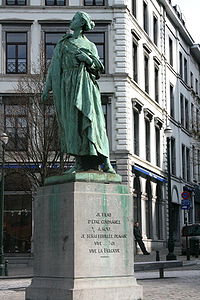Gabrielle Petit - Picture
More about World War 1

|
|
Gabrielle Petit

Picture - The stature of Gabrielle Petit in Place Saint-Jean Brussels
Gabrielle Alina Eugenia Maria Petit (20 February 1893, Tournai, Belgium − 1 April 1916, Brussels) was a Belgium woman who spied for the British Secret Service during World War I. Executed in 1916, she became a Belgian national heroine after the war's end.
Life
Gabrielle Petit was born to working class parents and was raised in a Catholic boarding school in Brugelette following her mother's early death. At the outbreak of the First World War, she was living and working in Brussels as a saleswoman . She immediately enrolled in the medical service of the Belgian Red Cross.
Petit's espionage activities began in 1914, when she helped her wounded soldier fiancé, Maurice Gobert, cross the border into the Netherlands to be reunited with his regiment. She passed along to British Intelligence information about the German army acquired during the trip. They soon hired her, gave her brief training, and sent her to spy on the German army. She proceeded to collect information about enemy troop movements using a number of false identities. She was also an active distributor of the clandestine newspaper "La libre Belgique" and assisted the underground mail service "Mot du Soldat". She helped several young men across the Dutch border.
Petit was betrayed, captured by the German army in February 1916, and executed two months later. During her trial, she refused to reveal the identities of her compatriots in exchange for clemency. She was imprisoned at St. Gilles Prison in Brussels, before being brought before a firing squad on April 1, 1916. Her body was buried at the execution field in Schaarbeek.
Unlike her contemporary, the Englishwoman Edith Cavell, who was also shot by the German army in Belgium, her story was unknown until after the war, when she became widely known and was made a national heroine. In May 1919, after a national funeral in the presence of the Belgian Queen Elisabeth, Cardinal Mercier and the Prime Minister Léon Delacroix, her mortal remains (and those of two compatriots A. Bodson and A. Smekens) were transferred to the city cemetery of Schaarbeek.
A monument honoring her service to Belgium was erected in Brussels. In her birthplace of Tournai, a square was named after her. Several books were written and films were made about her life after the war.
Gabrielle Petit biography at the Brooklyn Museum database of notable women. Accessed March 2009
Propaganda Postcards of the Great War Gabrielle Petit, by Miss Leen Engelen of the University of Louvain - Belgium. Accessed March 2009
Gabrielle Petit at First World War .com Accessed March 2009
More aircraft.
Source: WikiPedia